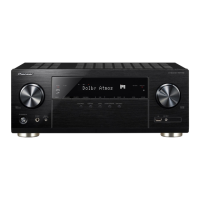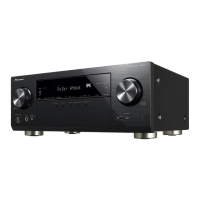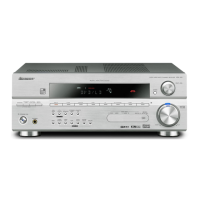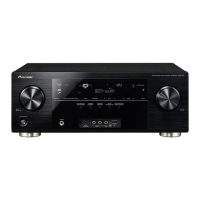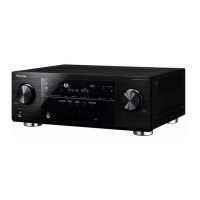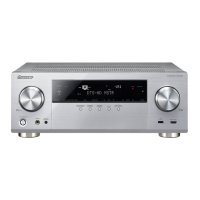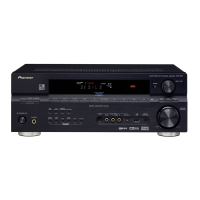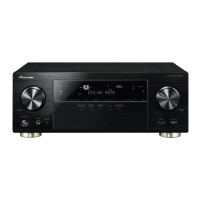Do you have a question about the Pioneer VSX-930-K and is the answer not in the manual?
Overview of the receiver's audio and video capabilities.
List of accessories included with the receiver for initial setup.
Guidelines for properly installing the receiver in its location.
Instructions for inserting batteries into the remote control unit.
Information on the effective range and conditions for the remote control.
Detailed explanation of the VSX-930 remote control buttons and functions.
Detailed explanation of the VSX-830 remote control buttons and functions.
Explanation of the receiver's display indicators and their meanings.
Description of the controls and indicators located on the receiver's front panel.
Introduction to connecting various external components to the VSX-930.
Diagram and explanation of the VSX-930 rear panel connection terminals.
Guidance on selecting speaker configurations and optimal placement for sound quality.
Instructions for connecting speaker wires and installing the speaker system.
Explanation of audio connection types, video converter, and HDMI details.
Guide to connecting TVs and playback devices using HDMI or other interfaces.
Instructions for connecting set-top boxes, audio components, amplifiers, and antennas.
Connecting to network, iPod, USB, MHL, and setting up multi-zone audio.
Connecting HDMI components to the front panel and optional IR receiver.
Final steps for plugging in the receiver and connecting power.
Introduction to connecting components to the VSX-830 receiver.
VSX-830 rear panel terminals, speaker application, and placement guidelines.
Instructions for connecting speaker wires and installing the speaker system.
Explanation of audio, HDMI, and component connections, including bi-amping.
Connecting TVs, set-top boxes, and other audio components.
Connecting subwoofer, AM/FM antennas, and network interface.
Connecting iPod, USB, MHL devices, and plugging in the receiver.
Three methods for performing initial receiver setup: special application, AVNavigator, or manual instructions.
Using AVNavigator software on PC/Mac or special application on mobile devices for setup.
Steps for establishing a network connection for the receiver via wired or wireless means.
Using different listening modes for enhanced audio playback and understanding Auto playback.
Switching MCACC presets and choosing input signals for optimal sound.
Utilizing Phase Control and Full Band Phase Control for enhanced sound reproduction.
Overview of network features including Internet radio and PC music playback.
How to play audio files and stream music using network functions like Spotify and HTC Connect.
Information on DLNA, Windows Media Player, and content compatibility.
Details on music and photo file formats supported for network playback.
Explanation of synchronized operations between Pioneer components using HDMI.
Steps for establishing Control with HDMI connections between devices.
How to configure HDMI settings for Control with HDMI functionality.
Prerequisites for synchronization and the Sound Retriever Link function.
Important warnings and precautions related to Control with HDMI usage.
Adjusting various audio settings like EQ, Phase Control, and Dynamic Range.
Configuring video settings such as scaling and resolution.
Selecting speaker/HDMI outputs and configuring HDMI 4K/60p input.
Adjusting speaker channel levels and volume absorber settings.
Operating multi-zone controls and network settings via web browser.
Setting the sleep timer and adjusting display brightness.
Reviewing system settings and performing a system reset.
Overview of the Remote Setup menu for configuring remote control functions.
Operating multiple receivers, controlling other components, and programming remote signals.
Erasing programmed remote settings and resetting remote control configurations.
Using All Zone Standby and setting operation mode switching time.
Making receiver settings using MCACC PRO/Advanced MCACC menus, including automatic and manual calibration.
Viewing calibrated MCACC settings and measurement results.
Managing MCACC presets, including renaming, copying, and clearing.
Adjusting speaker settings and other system configurations via the System Setup menu.
Manually configuring speaker sizes, levels, distances, and crossover frequencies.
Configuring MHL settings and other receiver options like Auto Power Down and Volume Setup.
Updating receiver software and configuring on-screen display settings.
Setting remote control modes and configuring zone settings.
Configuring network settings using the Safari browser.
Updating receiver firmware using Safari and a computer.
General guidance for resolving operational issues and malfunctions.
Troubleshooting common problems related to the receiver's power supply and audio output.
Troubleshooting issues with surround sound, subwoofer, Bluetooth audio, and sound output.
Troubleshooting video output, picture quality, and receiver settings problems.
Troubleshooting issues with the receiver's display and remote control functionality.
Troubleshooting problems related to HDMI, MHL, and AVNavigator software.
Troubleshooting issues with USB devices, iPods, and network connectivity.
Troubleshooting issues related to wireless LAN connection and setup.
Information about Wi-Fi, HDMI, HTC Connect, iPod, and MHL technologies.
Notices regarding software licenses and trademarks used in the product.
Copyright details, libpng notices, and definitions of technical terms.
Descriptions of surround sound formats and how listening modes function.
Guidelines for speaker positioning, height, orientation, and subwoofer adjustment.
Explanations of status messages encountered during network function operation.
Crucial information regarding HDMI connection details and unit cleaning instructions.
Distributor contacts, feature index, and technical specifications of the receiver.
A list of preset codes for controlling various audio/video components.
Overview of the receiver's audio and video capabilities.
List of accessories included with the receiver for initial setup.
Guidelines for properly installing the receiver in its location.
Instructions for inserting batteries into the remote control unit.
Information on the effective range and conditions for the remote control.
Detailed explanation of the VSX-930 remote control buttons and functions.
Detailed explanation of the VSX-830 remote control buttons and functions.
Explanation of the receiver's display indicators and their meanings.
Description of the controls and indicators located on the receiver's front panel.
Introduction to connecting various external components to the VSX-930.
Diagram and explanation of the VSX-930 rear panel connection terminals.
Guidance on selecting speaker configurations and optimal placement for sound quality.
Instructions for connecting speaker wires and installing the speaker system.
Explanation of audio connection types, video converter, and HDMI details.
Guide to connecting TVs and playback devices using HDMI or other interfaces.
Instructions for connecting set-top boxes, audio components, amplifiers, and antennas.
Connecting to network, iPod, USB, MHL, and setting up multi-zone audio.
Connecting HDMI components to the front panel and optional IR receiver.
Final steps for plugging in the receiver and connecting power.
Introduction to connecting components to the VSX-830 receiver.
VSX-830 rear panel terminals, speaker application, and placement guidelines.
Instructions for connecting speaker wires and installing the speaker system.
Explanation of audio, HDMI, and component connections, including bi-amping.
Connecting TVs, set-top boxes, and other audio components.
Connecting subwoofer, AM/FM antennas, and network interface.
Connecting iPod, USB, MHL devices, and plugging in the receiver.
Three methods for performing initial receiver setup: special application, AVNavigator, or manual instructions.
Using AVNavigator software on PC/Mac or special application on mobile devices for setup.
Steps for establishing a network connection for the receiver via wired or wireless means.
Using different listening modes for enhanced audio playback and understanding Auto playback.
Switching MCACC presets and choosing input signals for optimal sound.
Utilizing Phase Control and Full Band Phase Control for enhanced sound reproduction.
Overview of network features including Internet radio and PC music playback.
How to play audio files and stream music using network functions like Spotify and HTC Connect.
Information on DLNA, Windows Media Player, and content compatibility.
Details on music and photo file formats supported for network playback.
Explanation of synchronized operations between Pioneer components using HDMI.
Steps for establishing Control with HDMI connections between devices.
How to configure HDMI settings for Control with HDMI functionality.
Prerequisites for synchronization and the Sound Retriever Link function.
Important warnings and precautions related to Control with HDMI usage.
Adjusting various audio settings like EQ, Phase Control, and Dynamic Range.
Configuring video settings such as scaling and resolution.
Selecting speaker/HDMI outputs and configuring HDMI 4K/60p input.
Adjusting speaker channel levels and volume absorber settings.
Operating multi-zone controls and network settings via web browser.
Setting the sleep timer and adjusting display brightness.
Reviewing system settings and performing a system reset.
Overview of the Remote Setup menu for configuring remote control functions.
Operating multiple receivers, controlling other components, and programming remote signals.
Erasing programmed remote settings and resetting remote control configurations.
Using All Zone Standby and setting operation mode switching time.
Making receiver settings using MCACC PRO/Advanced MCACC menus, including automatic and manual calibration.
Viewing calibrated MCACC settings and measurement results.
Managing MCACC presets, including renaming, copying, and clearing.
Adjusting speaker settings and other system configurations via the System Setup menu.
Manually configuring speaker sizes, levels, distances, and crossover frequencies.
Configuring MHL settings and other receiver options like Auto Power Down and Volume Setup.
Updating receiver software and configuring on-screen display settings.
Setting remote control modes and configuring zone settings.
Configuring network settings using the Safari browser.
Updating receiver firmware using Safari and a computer.
General guidance for resolving operational issues and malfunctions.
Troubleshooting common problems related to the receiver's power supply and audio output.
Troubleshooting issues with surround sound, subwoofer, Bluetooth audio, and sound output.
Troubleshooting video output, picture quality, and receiver settings problems.
Troubleshooting issues with the receiver's display and remote control functionality.
Troubleshooting problems related to HDMI, MHL, and AVNavigator software.
Troubleshooting issues with USB devices, iPods, and network connectivity.
Troubleshooting issues related to wireless LAN connection and setup.
Information about Wi-Fi, HDMI, HTC Connect, iPod, and MHL technologies.
Notices regarding software licenses and trademarks used in the product.
Copyright details, libpng notices, and definitions of technical terms.
Descriptions of surround sound formats and how listening modes function.
Guidelines for speaker positioning, height, orientation, and subwoofer adjustment.
Explanations of status messages encountered during network function operation.
Crucial information regarding HDMI connection details and unit cleaning instructions.
Distributor contacts, feature index, and technical specifications of the receiver.
A list of preset codes for controlling various audio/video components.

